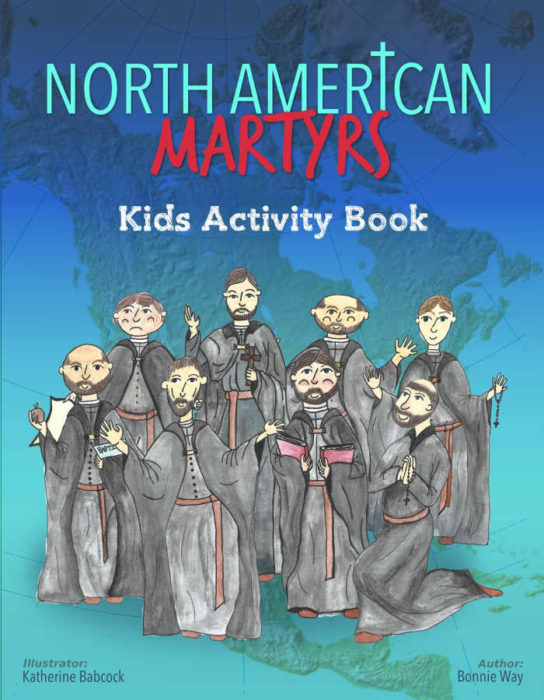Saint Isaac Jogues was a merchant’s son born in Orleans, France in 1607. His father died just after his birth, leaving his education to his mother, a strong Catholic. From his letters home to his mother during his missionary work in New France, it’s obvious that Saint Isaac maintained a close relationship with her.

As moms, St. Isaac’s life can inspire us to invest in our children’s education and to maintain close ties with them. Even when they are adults, they still need our prayers and influence in their lives.
He was also likely inspired in his missionary work by meeting other great men of faith, who were serving in New France. As moms, we can share stories of the saints with our children. We can also endeavor to help them meet and form relationships with others who will nurture their faith and vocation.
Saint Isaac Jogues’ Early Life and Education
Isaac was ten when he entered the new Jesuit college in Orleans. Donal O’Sullivan says he
“showed early that quality of gentle strength that was to mark the man. A steady student, courteous in manner and expert in swimming and running, he entered into the strong stream of his school’s religious life with the same zest with which he plunged into his native Loire.”
He began his novitiate training with the Jesuits in October 1624. The following year, he met Father Jean de Brebeuf, who was about to sail for New France. From 1625-1628, he studied philosophy at La Fleche. Louis Lalemant was one of the teachers there, and had two brothers and a nephew serving as missionaries in Canada. From him, Jogues may have heard stories that turned his heart towards the mission in New France.
He then taught literature for three years before studying theology at the College of Clermont, University of Paris. He was ordained in February 1636. That April, he sailed for New France with the new governor. Lives of the Saints records, “He was already recognized as an able scholar, with talents for writing and teaching.”
Saint Isaac Jogues in New France
Father Jogues wrote often to his mother from New France, asking for her prayers. On his arrival, he told her, “It is difficult to experience in this world a joy more excessive and more overflowing than that I felt on my setting foot in New France, and celebrating my first Mass here.” He was also realistic about spending the rest of his life in New France, saying, “I have no hope of seeing you in our lifetime. May God in His goodness unite us both in His holy abode!”
In August, he met Fr. Antoine Daniel, who brought a report of the missionaries’ work among the Huron. Fr. Jogues was chosen to replace Fr. Daniel, who went to Quebec for a sabbatical. In September, he joined Fr. Brebeuf near present-day Georgian Bay.
Of their work, O’Sullivan notes, “Much of the missionaries’ life was spent either on the trail with the Indians or, in winter, in their hovels.” Despite this, Fr. Jogues’ letters to his mother convey great excitement: “I have always felt a great love for this kind of life, and for a profession so excellent, and so akin to that of the Apostles.”
Saint Isaac Jogues Among the Huron
Immediately after arriving at Fr. Brebeuf’s mission (which had been established ten years earlier), Fr. Jogues fell ill of the fever. The missionaries had little food and lived in “crude huts” (Lives of the Saints). When they recovered, the epidemic broke out among the Hurons, who blamed the priests. Fr. Brebeuf managed to placate them, but the Huron swung between favour for the priests and suspicion of them.
In 1639, another epidemic swept through the mission. The missionaries did what they could to help the Hurons, but they were blamed for the illness again. When the priests recovered without assistance from the village sorcerer, Wynne says the sorcerer “was convinced that they were greater sorcerers than himself.” The priests’ belongings (books, letters, crucifixes), because they were strange to the Hurons, became objects of suspicion.
The six years that Fr. Jogues spent among the Hurons were years of constant danger. In the Catholic Encyclopedia, Thomas Campbell says, “Though a daring missionary, his character was of the most practical nature, his purpose always being to fix his people in permanent habitations.” He travelled great distances with his fellow missionaries and was likely the first white man to reach Sault Ste Marie.
The Iroquois Capture Isaac Jogues
In the summer of 1642, the mission at Ste. Marie was again faced with a bad harvest and much sickness, among both the priests and the Huron. Fr. Jogues went to Quebec to meet with his superiors and pick up supplies, despite the fact that the Iroquois were once again on the war path.
Historian John J. Wynne explains that the “Iroquois were the fiercest Indian tribes in the east . . . bitterly opposed to the French, implacable to the Hurons, hateful of the Black Robe, as the missionary was called on account of his clerical garment” (The Jesuit Martyrs of North America).
Fr. Jogues made it safely to Quebec and was returning with Rene Goupil, a layman and several Huron when the Iroquois attacked on August 2. Most of the Huron fled into the forest and Goupil was captured, but several of the Huron converts tried to defend themselves.
Fr. Jogues had opportunity to escape, but says in a letter to his superior (written a year after the event), “I, who was barefoot, would not and could not flee,—not willing, moreover, to forsake a Frenchman and the Hurons, who were partly captured without baptism.”
The Iroquois tortured their French prisoners, biting off their fingers and tearing out their nails. Fr. Jogues continued to instruct the Huron captives (who were for a time spared the torture) and baptized many of them. The Iroquois then conducted their prisoners back to their villages.
Isaac Jogues Among the Iroquois
 Over the next month, Fr. Jogues and Goupil were subject to various tortures as they were led from village to village. O’Sullivan says of these tortures, “The details of these torments are too revolting for description. Some measure of their horror may be gauged from the fact that, when they were over, only two finger-nails remained to Fr. Jogues; all his fingers were crushed, his left index finger was a stump, his left thumb was gone.”
Over the next month, Fr. Jogues and Goupil were subject to various tortures as they were led from village to village. O’Sullivan says of these tortures, “The details of these torments are too revolting for description. Some measure of their horror may be gauged from the fact that, when they were over, only two finger-nails remained to Fr. Jogues; all his fingers were crushed, his left index finger was a stump, his left thumb was gone.”
Fr. Jogues spent thirteen months as a prisoner and slave of the Iroquois. Despite this, he continued to secretly minister to other Huron prisoners. He even learned the Iroquois language so that he could preach to his captors. Finally, after much prayer, Fr. Jogues took an opportunity of escape offered by Dutch traders at Fort Orange (Albany).
On Christmas Day in 1643, he landed back in France, and returned to the Jesuits in Rennes and then to his mother in Orleans. She must have been overjoyed at seeing him again, for he hadn’t expected to leave his missionary work.
Isaac Jogues Returns to New France
In France, Fr. Jogues received a hero’s welcome. The Catholic Encyclopedia records that he was even “allowed by Pope Urban VII the very exceptional privilege of celebrating Mass, which the mutilated condition of his hands had made canonically impossible; several of his fingers having been eaten or burned off.” He was also called a martyr by the pope.
However, Fr Jogues found himself homesick for New France. In the spring of 1644, he returned to New France and was stationed in Quebec and Montreal, but requested to be sent to the Iroquois.
Two years later, he went back briefly as a peace ambassador. Then, since the “Iroquois had promised to bury the hatchet” (O’Sullivan), he was given permission to return. Along with Jean de Lalande, a layperson, he travelled into Iroquois territory in September.
Isaac Jogues’s Death
After Fr. Jogues’ peaceful visit to the Iroquois, the tribe fell ill and their crops failed. Campbell explains, “This double calamity was ascribed to Jogues whom the Indians always regarded as a sorcerer.” Warriors were sent to capture and kill Fr. Jogues. He received news of this, but continued on his journey. He was deserted by everyone except Lalande.
He met the Iroquois near Lake George and was captured. On October 18, 1646, Fr. Jogues was murdered while entering an Iroquois cabin for a feast. Lalande was murdered the next day when he tried to retrieve Jogues’ body. Both their heads were stuck on poles and their bodies were thrown into the river.
Isaac Jogues was canonized, along with the other seven Canadian martyrs, in 1930. Their feast day is celebrated on September 26 in Canada. They are also known as the North American Martyrs, whose feast day is celebrated in the United States on October 19.
Saint Isaac Jogues, pray that I may help my children to attain a good education and to read the lives of saints like you. May your life inspire me to maintain a close relationship with them and always keep them in my prayers, even when they are grown and on their own. Amen.

Subscribe to my weekly email newsletter to download your FREE printable Canadian Saints & Blesseds Kids Activities Pack, which includes 8 Bingo cards with 30 Canadian saints’ and blesseds’ names, crossword puzzles and word searches, saint matching and sorting games, and a saint profile sheet. These activities are intended for kids about Grades 2+ (or children who can read and write). This Kids Activities Pack would be great for catechism classes, homeschool lessons, or a Canadian All Saints Day party.

No Responses Yet